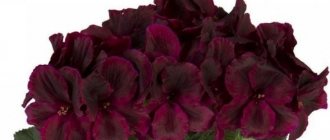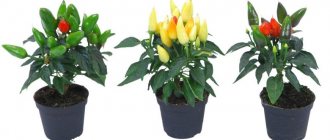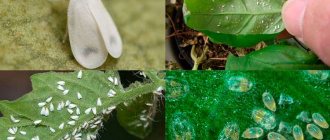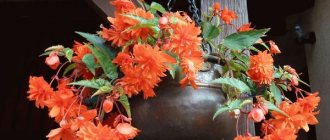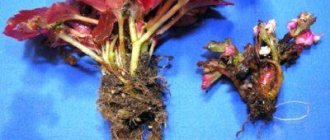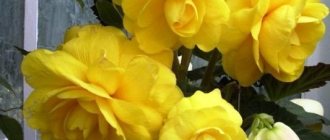Begonias are quite popular ornamental plants; they can often be found in the homes of Russian residents. There are many types of this flower, so from them you can always choose the one that will most fully meet your wishes. For example, royal begonia is a plant with beautiful leaves, which is not only very decorative, but also has phytoncidal properties, which means it purifies the indoor air from pathogens. It is quite unpretentious, caring for it at home is easy, but amateur gardeners still need to know its features.
Botanical description
Royal Begonia is directly related to the Begoniaceae family. Another name for this variety is Rex. Among the people, royal begonia received the nickname “frostbitten ear” or “Napoleon’s ear” , this was in 1812 during the flight of French troops from Moscow. Indeed, the outline of the leaf on the lower red side resembles a frostbitten ear.
In nature, this plant can be found in northeast India. Height varies from 15 to 40 cm.
The flower is distinguished by asymmetrical leaves, which have a beautiful pattern and unusual color. The color scheme is represented by green-brown shades with hints of silver. The shape of the leaf is also different and can be heart-shaped, round, oval, snail-shaped. The edges of the leaves can be carved or wavy and only occasionally whole.
The stem of the plant is quite large, fleshy , the root system is branched and sometimes protrudes to the surface.
Despite all the beauty of the leaves, the flowering of the royal begonia is rather sparse and for best growth the inflorescences are often removed.
Royal begonia varieties with photos
In mid-latitudes, the following varieties of royal begonia are most often found in indoor cultivation:
Red Leaf Begonia Fista
The compact bush has an unpretentious character. The greenish-red leaves have an unusual round shape. This variety is available in almost every store specialized in selling flowers.
Cuff
This variety also does not have any special requirements for care and growing conditions. Its creeping stem is decorated with showy pale green leaves. There are red veins on the inside.
Hogweed
The homeland of this variety is Brazil. It stands out for the extremely unusual shape of its leaf blades, which look more like the foliage of hogweed. On the surface of the pale pink stem there is a slight pubescence, which is located along the entire length.
Mini Merry Christmas
This spectacular hybrid was obtained as a result of the work of breeders. This flower is part of the variegated subspecies. Its foliage has highly decorative qualities. The color of the leaf blade changes: in the middle it is burgundy with whitish veins, then it becomes dark green, and closer to the edge it is almost black.
The bush is compact, but it is decorated with incredibly beautiful foliage that has a bizarre shape. On the surface of the gray-silver leaf plates there is a clearly visible spiral pattern. The foliage itself is matte, and on its surface there is pubescence, represented by a short pile.
Dollar Down
Carved leaf plates of unusual cherry color look very impressive. The top of the leaves is pointed, and along the edge there is a black border. Such a plant can become the main decoration of any room.
This hydride is the largest compared to other varieties. The size of the plant can reach almost 0.4 m. The leaf plates have a clear shape, with a sharp point at the tops. They are painted in a pale green shade with large areas of white.
Dark Mambo
This is a very unusual and spectacular begonia. Its foliage has a unique dark green color that looks more like black. On its surface there are thin yellow veins. The foliage also has an unusual spiral shape. The flower looks especially impressive against a light background.
Indian Summer
Despite the fact that the bush is compact, its leaves are large. They almost completely cover the stems. The plant has an original black and pink color.
The carved foliage of this plant is similar to the bright strokes of fireworks in the night sky. Also adding to the originality of this variety is the burgundy edging and the spectacular green-violet pattern on the leaf blades.
Beleaf inca flame
Despite the fact that the foliage of this variety has a uniform color and also lacks contrasting veins, it is still highly decorative. This is all thanks to the beautiful bright red color of the leaves.
Photo
Below are photos of royal begonia grown at home:
Photo of royal begonia flowering:
Transfer
Transplantation is an obligatory stage in plant care. Thanks to it, rejuvenation occurs. It needs to be done once every three to four years. You will need a fresh soil mixture. You can prepare it yourself or buy it ready-made in a specialized store. Fresh soil should include leaf and turf soil, peat mixture and sand (preferably river), in a ratio of 2:1:1:1, respectively. To recharge, you can add a little coniferous bark or leaf humus.
The bottom of the container selected for transplantation is traditionally filled with drainage.
Begonia transplant
Care
Despite its ease of care, the royal begonia will need to create a number of conditions under which it will grow healthy and delight the owner with its beauty.
Location and lighting
Royal begonia needs a lot of light, but direct sunlight can be destructive for it - burns will appear on the leaves and the flower will die. The ideal place for it would be opposite the window : a shelf, table or cabinet.
Be sure to use tulle to diffuse the light. The sun's rays negatively affect not only the health of the flower, but also its appearance. From too much sun, the leaves become faded and dry at the edges.
Watering frequency
Watering is required abundantly. When the top layer of soil dries out, the flower should be watered immediately. In winter, the amount of watering should be reduced, following the same rule regarding drying out the soil.
The main rule of watering is to provide the indoor plant with the amount of water it needs, while not allowing the liquid to stagnate in the root system. To do this, you can put moistened expanded clay, pebbles or sphagnum moss in the tray of the pot.
Air humidity
Due to its origin, royal begonia loves moist air, so you should stick to 50-60% .
There are several possible ways to humidify the air:
- Spray the air around the flower, avoiding droplets getting on the leaves.
- Place wet pebbles or expanded clay on a tray. You can also use sphagnum moss or a cloth soaked in water.
- Buy a humidifier and set it to the required level to maintain moisture.
It is necessary to maintain high humidity only in summer ; in winter, this is not necessary.
A couple of times a month, the leaves of the plant should be wiped from accumulated dust using a soft sponge or cloth.
Temperature Requirements
A thermometer reading of 18-24 degrees will be optimal for royal begonia. If the temperature rises above 26 degrees, the flower may die.
In winter, it is better to place the flower on an insulated balcony, where the air temperature should not fall below +16 degrees.
Remember, royal begonia does not like drafts, so in winter you should not place the pot close to the window.
Fertilizer
You need to feed the plant no more than once a month .
You can purchase complex mineral fertilizers. Before using them, the flower must be thoroughly moistened. Organic fertilizers also work well for royal begonias. To prepare them you will need horse or cow dung diluted with water in a ratio of 1:5.
Transfer
You need to replant a houseplant at least once a year in the spring. In order not to harm the plant, when replanting you need to follow a number of rules:
- The new pot should be wider than the bush by only 2-3 cm in diameter. In this case, the depth should remain the same.
- When replanting a flower, the roots should be handled very carefully. When removing the plant, the soil must be moistened and the earthen ball carefully turned over. If this cannot be done, then the old pot will have to be carefully broken.
- The soil must be prepared in advance, and the container for replanting should be wide, not deep. This is due to the rapid expansion of the root system.
- Several varieties of this family can be placed in one large flowerpot. The result will delight the owner with an original flower arrangement.
Flower rejuvenation is carried out once every 3 years.
Soil composition
The soil should be laid as follows:
- A drainage layer consisting of pebbles or expanded clay is laid at the bottom;
- The drainage is sprinkled with a layer of sand or charcoal;
- A soil mixture of peat, leaf and turf soil is laid;
- The soil surface is thoroughly moistened and the flower can be planted.
When laying layers, you need to remember that the drainage layer should not occupy more than a third of the pot , and lay the substrate not to the very edges, but with an indentation of a couple of centimeters. When planting, the upper part of the root must remain on the surface, otherwise it may rot.
Trimming
During flowering, it is recommended to trim the inflorescences, because their appearance significantly affects the appearance of the plant - it becomes depleted, and the leaves lose their attractiveness.
At the end of the winter period, with the arrival of spring, active growth occurs. By this time, you should prepare and pinch the rhizome, and move its young parts to the center of the pot. If everything is done correctly, the royal begonia will delight you with the splendor of its leaves and the formation of young shoots.
How to replant begonia
Royal begonias like slightly acidic soil, pH 5.0-6.0. But the main requirement for the soil structure is that it must be very loose, airy, rich in humus and dry out quickly, no longer than 2 days completely. Only garden soil from garden beds and clean peat are not suitable for planting Rex begonias. Pure leaf soil (collected under last year's leaf litter somewhere in a linden park) is more suitable. There can be several options for soil mixtures:
- 2 parts leaf, 1 part peat, 1 part coarse river sand (or vermiculite).
- 2 parts peat soil, 1 part coconut substrate (from briquettes), 1 part coarse river sand (or vermiculite), 1 part pine bark.
- 2 parts universal soil, 1 part vermiculite, 1 part sand, 1 part pine bark.
As you understand, sand and vermiculite are leavening agents. Pine bark also loosens and further acidifies the soil. And even with the addition of loosening components, it is necessary to ensure that the substrate in the pot does not cake; periodically loosen it with a thin, sharp stick. And when a salt crust forms on the soil surface, be sure to replace the top layer of soil and soften the water for irrigation.
Royal begonias grow well in shallow and not too spacious pots; if the pot is large, the soil will dry out for a long time - this contributes to the development of pathogenic flora and rotting of the roots. But it is better to replant begonias annually, in fresh soil, and in the same pot, if the root system has not grown too much.
Some miniature rex begonias can be grown in wide open aquariums, in fact, all the conditions for them are similar to the requirements of orchids. Also air humidity, the same requirements for light and watering, even for fertilizers and pots. When growing Rex begonias on wide trays of water, and especially in aquariums, you can and even need (!) to use pots with drainage holes at the bottom and sides of the pot. Basically, you can grow king begonias in wicker (plastic) baskets, or you can make the holes yourself. Perhaps I will surprise someone with such recommendations, this is my personal experience, but it helps to avoid root rot, bacterial spots and other diseases. In nature, Rex begonias grow in the surface layer of the earth, which is leaf litter, branches and tree branches - this is a very loose substance. Many begonias lead a semi-epiphytic and epiphytic lifestyle.
I am against adding sphagnum moss to the soil for royal begonias, as it takes a long time to dry and absorbs moisture too much, but you can spread wet moss between pots to increase air humidity. And against growing Rex begonias in clay pots, the soil dries out quickly enough, but some of the roots stick to the unglazed sides of the pot, and the hole at the bottom is usually the only one and small. You can always slightly squeeze the sides (walls) of plastic pots, thereby loosening and aerating the soil.
Reproduction methods
There are several propagation methods for royal begonia:
- Cuttings;
- Using a sheet;
- Seeds;
- Dividing the root.
Each of them has its own nuances, which we will discuss further.
Cuttings
Reproduction by cuttings is possible only from adult plants (from 3 years old) . The procedure is as follows:
- For propagation, choose strong, healthy cuttings 10 cm long. They must be cut with a knife, the lower leaves removed, and the upper ones cut in half.
- Dry the cuttings for 2 hours and treat the cut with Kornevin or Heteroauxin.
- Prepare a substrate consisting of special soil for begonias and river sand.
- Plant the cuttings in a container to a depth of 2 cm, cover with glass or polyethylene.
- Regularly moisten the soil with a sprayer and periodically ventilate the container.
- When the first shoots appear (after 4-5 weeks), remove the protective film.
Leaf
Leaf propagation is suitable for both young and adult royal begonias. The technology is as follows:
- To obtain new plants, select a large, healthy-looking leaf and cut it into several parts so that each of them has a central vein.
- Prepare the soil for planting: mix wet sand and peat in equal proportions.
- Place the pieces of leaf on the surface of the soil at a distance of several centimeters from each other.
- We press the leaves a little deeper into the soil (no deeper than 1 cm) or sprinkle them with a little soil.
- Cover the container with transparent film or glass and place it on the windowsill.
As the soil dries, you will need to moisten it with a sprayer so that it is moderately moist. After the first shoots appear (after 6-8 weeks), the container with plants can be opened slightly.
Seeds
The seed propagation method is considered the most difficult of all, because
requires much more time and attention. For planting, you can choose regular (untreated) or granulated seeds. The latter are much easier to work with, so experienced gardeners often choose them.
Instructions for proper landing are as follows:
- As a general rule, seeds should be planted in early spring. Before planting, they should be soaked in a 1% manganese solution for 30-45 minutes.
- Wash the seeds and plant them in a peat tablet, which must be moistened in advance.
- Each tablet is placed on a tray and covered with cling film or glass on top. To keep the tablet always moist, water is constantly added to the tray.
- After the formation of the first shoots (usually after 2-3 weeks) and the appearance of the 3rd leaf, a dive is performed. The procedure must be repeated 8 weeks after emergence.
- Young plants are planted in separate pots.
To grow royal begonia from seeds, the optimal room temperature should be at least 20-22 degrees.
Dividing the bush
The method is most optimal for adult representatives of this variety who are more than 3 years old. The procedure should be carried out in the spring . The procedure is as follows:
- The flower must be carefully removed from the pot, and then the entire root system must be thoroughly rinsed with cool running water.
- Divide the rhizomes with a sharp knife so that 1-2 buds remain on each part.
- Sprinkle the cuts with charcoal.
- Place the flowers in separate pots and water generously.
To speed up the process, you can use Kornevin or Heteroauxin.
General information
Royal Begonia or Rex Begonia is one of the species included in the Begonia genus of the Begoniaceae family. It comes from the countries of Southeast Asia, where it grows naturally. In Europe it is grown only as an ornamental houseplant.
Description of royal begonia:
- herbaceous perennial with strong creeping rhizome;
- with a short fleshy stem studded with reddish bristles;
- the leaves are large (about 30 cm long and 20 cm wide), asymmetrical, pointed, with jagged edges, sitting on oblong petioles;
- the upper leaf blades are slightly pubescent, the lower ones are pubescent along the veins;
- the leaves are reddish below, on top - varied and brightly colored, may have red, green, purple and lilac, brown, silver and pearlescent inclusions;
- the veins can also be of a different color.
The color of the flower depends on the variety. Begonia blooms with single pinkish flowers located on a short peduncle. But against the background of bright leaves they do not look good and have no decorative value. Flowering occurs in spring and summer (depending on the variety). After the flower throws out its peduncles, it is recommended to cut them off.
It is interesting that the decorative properties of begonia - the unusual shape and bright color of the leaves - are dictated by its physical needs. Thanks to coloring, the temperature on the surface of the leaves increases, which increases the evaporation of moisture. This stimulates the work of the roots, due to which they develop more intensively. Another feature - the asymmetry of the leaves - allows them not to block each other from sunlight.
How to make it bloom?
Experienced gardeners manage to achieve flowering within 6-12 months. To do this, you must adhere to a number of rules:
- Trim all female flowers of young begonias;
- Fertilize the plant 3 times a month;
- Do not apply fertilizers containing nitrogen;
- Trim spent flowers to prolong flowering.
Not all varieties have a pleasant aroma; some do not have it at all. For example, the Bauman variety has a pleasant aroma and has medicinal properties - it helps cleanse the bronchi and helps with problems with the respiratory tract.
At the end of flowering, the plant needs rest. In place of the flowers, small boxes with seeds are formed . The frequency and duration of flowering of the royal begonia depend on the correct care of it and whether pollination occurs.
Features of the species and the most popular varieties
Begonia rex (B. rex Putz), as this variety is also called, is distinguished by the following characteristics:
- has powerful creeping roots;
- the stem is small, thick, densely covered with red soft bristles;
- leaves are large, with pronounced asymmetry, pointed with long petioles and jagged edges;
- the color of the leaves is bright and varied, including green, scarlet, crimson, lilac and even silver shades;
- has small, pink, dull flowers; some plants (such as fireworks begonia) have no flowers at all.
Cleopatra begonia is of great interest to flower growers and housewives. It does not require special care, has bright green foliage, and is characterized by intensive growth.
One of the most beautiful and sought-after varieties is fireworks begonia. It fully justifies its name, since its color combines several shades at once: in the center the leaf has a black-violet color, which turns into dark green. Silver-light green spots are visible on a dark green background. The edge of the leaf is edged with lilac-violet color. Begonia fireworks will enliven the interior of any room. This variety looks very impressive in the photo.
The snail begonia variety also has many fans. It is characterized by large rounded leaves. In the center and along the edges the leaves are covered with a brown-olive color; between them there is a wide strip of silver color, which makes the pattern look like a curl of a snail shell. The leaves are curled at the base.
Diseases and pests
For royal begonia, as for many indoor flowers, harmful insects pose a particular danger.
As a rule, they attack a weakened plant, which is why it is so important to follow all the rules for caring for it. Major pests include spider mites, scale insects and thrips. There are several methods to combat them:
- If detected in a timely manner, the insects are removed mechanically, and the flower is temporarily quarantined, away from healthy plants. Treat with soapy water.
- If the first method does not work or there are too many insects, then spraying with insecticides will be necessary. You can use Actellik, Fitoverm or Nurell-D.
Prepare your own pest repellent:
- Take onions with brown skins, finely chop or chop them;
- Dilute 1 teaspoon in a liter of water and leave for a week;
- Strain and spray the flower with the prepared solution.
In addition to pest damage, it is important to pay attention to the rules of care, because at the slightest violation the flower can get sick. The most dangerous of them are:
- Powdery mildew, which appears due to sudden changes in temperature and excess air moisture. It is not difficult to detect - a characteristic white coating will appear on the plant.
- Root rot. The main reason for its appearance is too frequent watering and stagnation of water in the roots. Therefore, it is very important to create a drainage layer at the bottom of the pot and not to overdo it with watering.
To help the plant you will need to remove the affected areas and treat it with a fungicide solution: Topaz, Skor or Fitosporin. In some cases, replanting into fresh soil will be required.
Problems of growing begonias
There are and will be problems with Rex begonias. This culture is as demanding as orchids. It is not without reason that they are classified as a separate group among decorative deciduous begonias.
First of all, the problem is extreme susceptibility to bacterial rot and fungal diseases in conditions of high air humidity. And they need this moisture paramount. But even if we place begonias on wide trays with water, and miniature ones in a terrarium, the problem remains - air movement. It is practically absent from the apartment, and the one that appears during ventilation creates a draft. Lack of ventilation is not a problem when the air is dry. But if it is very humid, mold fungi and bacteria multiply several times more intensely in stagnant air. In orchidariums, for example, to avoid such problems, they install a fan, and more than one.
Therefore, the success of growing royal begonias in an apartment largely depends on the ability to maintain high air humidity and at the same time painlessly ventilate at any time of the year. Excessive humidity, by the way, is detrimental to plants at low temperatures.
The second problem that arises with Rex begonias is the inability to water with soft water. No matter how you settle and boil, a salt coating still forms on the surface and spots on the leaves. What to do? First, go to a pet supply store and ask for a product to prepare aquarium water for fish. These products soften water in a matter of minutes. But few people use them for indoor flowers, but in vain. Second, reconsider the fertilizer you use to water your begonias. Among them there are many completely unsuitable ones, as I wrote about above: alkaline, with a large dose of nitrogen. Some don't even list the ingredients. Only fertilizers that acidify the soil, with microelements in chelated form, are suitable for us. At worst, it is safer to use fertilizers for conifers, azaleas or orchids than to take something dubious for decorative deciduous trees or supposedly “for begonias” poured from the same barrel as for ficus or palm trees.
Photo gallery
tsvetochnyy_blyuz
tsvetochnyy_blyuz
marinavlmk__
irina_fialki74
olivka.de
olgamakarovaizorla
amaryllis_blog
bilyknata7
Signs and superstitions
Royal Begonia, according to popular belief, is considered a talisman that brings good luck and creates a favorable environment in the home. But in order for a plant to bring good luck, it needs to be given warmth and care.
Begonia Royal is a popular variety that has beautiful flowering. To grow a healthy plant you need to follow the care instructions. Begonia needs certain conditions, without which it cannot bloom.
Home kit Modno.ru
1077 ₽ More details
Home kit Modno.ru
671 ₽ More details
Women's summer sports suits
